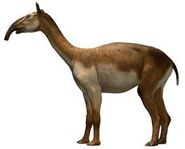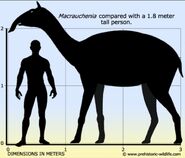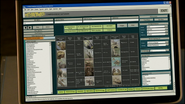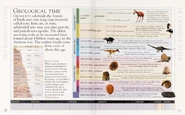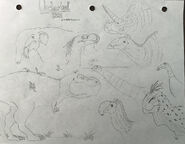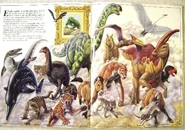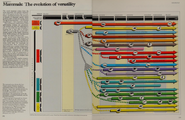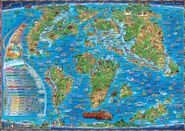| Macrauchenia | |
|---|---|

| |
| An artist's interpretation of Macrauchenia patachonica. | |
| Scientific classification | |
| Kingdom: | Animalia |
| Phylum: | Chordata |
| Class: | Mammalia |
| Order: | †Litopterna |
| Family: | †Macraucheniidae |
| Genus: | †Macrauchenia |
| Type species | |
| †Macrauchenia patachonica Owen, 1838 | |
| Referred species | |
| |
Macrauchenia is an extinct genus of mammals from South America from the late Miocene to the late Pleistocene. This bizarre-looking animal was a member of a group of extinct animals called litopterns, only known from and endemic to South America. Initially, their cladistics were unknown - until more fossils are found they are assumed to be distant relatives of familiar hoofed mamals, hypothesized to be closely related to perissodactyls (odd-toed ungulates). Macrauchenia was the last of its kind, and its extinction (along with Toxodon’s) saw the end of the litoptern lineage. The first Macrauchenia skeleton was discovered by Charles Darwin on a stop-over during his famous journey on board The Beagle. Since then many more remains have been found in the Lujan formation in Argentina. Macrauchenia appeared in the fossil record some 7 million years ago in South America (in the Miocene epoch). It is likely that Macrauchenia evolved from either Theosodon or Promacrauchenia.
Notoungulata and Litopterna were two ancient orders of ungulates which only occurred in South America. Many of these species became extinct through competition with invading North American ungulates during the Great American Interchange, after the establishment of the Central American land bridge. A few survivors of this invasion were the litopterns Macrauchenia and Xenorhinotherium and the large notungulates Toxodon and Mixotoxodon. These last original South American hoofed animals died out eventually at the time of the arrival of humans at the end of the Pleistocene, along with numerous other large animals on the American continent that outcompeted it (such as mammoths, horses, camels, and tapirs). As this genus was the last of the litopterns, its extinction ended that line of mammals.
Taxonomy[]
Macrauchenia was a member of the litopterns, a group of unusual mammals whose genetic relationships to other mammals was mysterious and unknown. However, recent evidence from genetic testing has shown that litopterns (including Macrauchenia) are related to perrisodactyls.[1]
Description[]

A life restoration of Macrauchenia patagonica
Macrauchenia was a member of the order litopterna, which belonged to very specific South American ungulates. Most of the representatives of litopterns went extinct at the end of the Pliocene, after an overland to North America and the emergence of new predators and competition from new prey. Macrauchenia were sufficiently attuned to adapt to survive until the end of the Pleistocene. M. patachonica died, apparently, only 10 thousand years ago. Macrauchenia was a hoofed mammal with three hoof-like toes. It reached a height of 1.4 m at the shoulders, which corresponds to the modern zebra, and weighed around 270 kg. Long and very strong legs ended in three fingers. The neck was very long, and the front of the snout is likely to end with a proboscis, adapted for plucking leaves, although the structure of the teeth are more like that of a grass eater. Remains were found of Macrauchenia, primarily in the southeastern Pampas, but the findings are also known in Venezuela.
Their general appearance resembles to camels and tapir, but recent findings suggest that it maybe have more so resembled horses and moose.
Distribution[]
Macrauchenia was distributed from Venezuela in the north to Argentina in the south (near Tierra del Fuego), as well as east into Brazil.
In popular culture[]
- Macrauchenia appeared in Walking with Beasts.
- Macrauchenia appeared in the video game Jurassic Park Builder.
- Macrauchenia appeared in the video game Zoo Tycoon.
